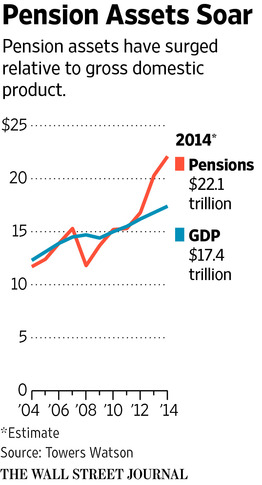
Institutional investors around the globe believe equities will be the best-performing asset class in 2015, according to a survey released Monday.
Investors are also bullish on alternatives, but not as thrilled when it comes to bonds, according to the survey.
The results summarized by Natixis Global Asset Management:
Forty-six percent of institutional investors surveyed say stocks will be the strongest asset category next year, with U.S. equities standing above those from other regions. Another 28 percent identify alternative assets as top performers, with private equity leading the way in that category. Only 13% predict bonds will be best, followed by real estate (7%), energy (3%) and cash (2%).
Natixis solicited the market outlook opinions of 642 investors at institutions that manage a collective $31 trillion. The survey found:
– Realistic expectations of returns: On average, institutions believe they can realistically earn yearly returns of 6.9 percent after inflation. In separate surveys by Natixis earlier this year, financial advisors globally said their clients could anticipate earning 5.6 percent after inflation1 and individuals said they had to earn returns of 9 percent after inflation to meet their needs.2
– Geopolitics leads potential threats: The top four potential threats to investment performance in the next year are geopolitical events (named by 17% of institutional investors), European economic problems (13%), slower growth in China (12%) and rising interest rates (11%).
– Focus on non-correlated assets: Just under three-quarters of respondents (73%) say they will maintain or increase allocations to illiquid investments, and 87% say they will maintain or increase allocations to real estate. Nearly half (49%) believe it is essential for institutions to invest in alternatives in order to outperform the broad markets.
– Words of advice for retail investors: Among the top investment guidance institutions have for individuals in the next 12 months: avoid emotional decisions.
[…]
“Institutional investors have an enormous fiduciary responsibility to fund current goals and meet future obligations,” said John Hailer, president and chief executive officer for Natixis Global Asset Management in the Americas and Asia. “The current market environment makes it difficult for institutions to earn the returns that are necessary to fulfill both short-term and future responsibilities. Building a durable portfolio with the proper risk management strategies can help investors strike a balance between pursuing long-term growth and minimizing losses from volatility.”
[…]
“Institutional investors have an unusually good perspective about markets and long-term prospects,” Hailer said. “Like ordinary investors, institutions have short-term worries. They also feel the pressure to take care of current needs, no matter what the markets are doing. Because of their longer-term time horizon, they offer valuable perspective.”
The full results of the survey can be read here.




